Lanzhou
Lanzhou (Chinese: 兰州) is the capital and largest city of Gansu Province in Northwest China.[4] Located on the banks of the Yellow River, it is a key regional transportation hub, connecting areas further west by rail to the eastern half of the country. Historically, it has been a major link on the Northern Silk Road and it stands to become a major hub on the New Eurasian Land Bridge. The city is also a center for heavy industry and petrochemical industry.
Lanzhou 兰州市 | |
|---|---|
From top, left to right: Lanzhou skyline, Chanyuan Temple, Xiguan Mosque, Lanzhou city from Five Springs Park, Lanzhou beef noodles, Yellow River Mother sculpture | |

| |
.png) Location of Lanzhou City jurisdiction in Gansu | |
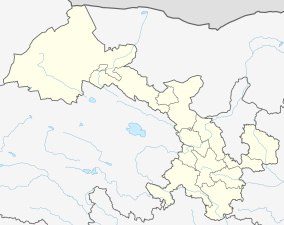 Lanzhou Location of the city center in Gansu 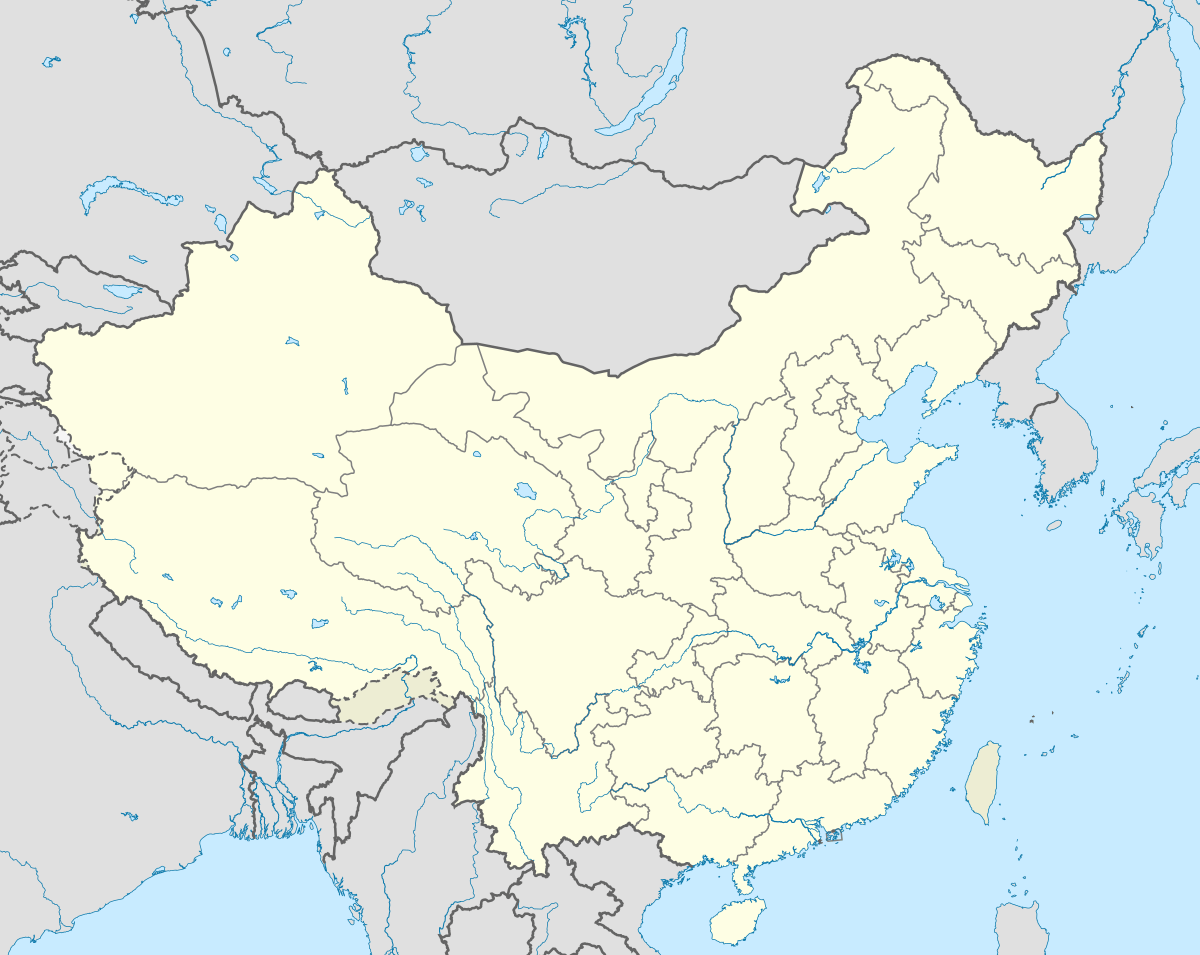 Lanzhou Lanzhou (China) | |
| Coordinates (Gansu People's Government): 36°03′38″N 103°49′36″E | |
| Country | People's Republic of China |
| Province | Gansu |
| County-level divisions | 8 |
| Municipal seat | Chengguan District |
| Government | |
| • Party Secretary | Li Rongcan |
| • Mayor | Zhang Jianping |
| Area | |
| • Prefecture-level city | 13,300 km2 (5,100 sq mi) |
| • Urban (2018)[1] | 298 km2 (115 sq mi) |
| Population (2010 census) | |
| • Prefecture-level city | 3,616,163 |
| • Density | 270/km2 (700/sq mi) |
| • Urban (2018)[1] | 2,890,000 |
| • Urban density | 9,700/km2 (25,000/sq mi) |
| Time zone | UTC+8 (China Standard) |
| Postal code | 730000 |
| Area code(s) | 931 |
| ISO 3166 code | CN-GS-01 |
| License plate prefixes | 甘A |
| GDP (2015) | CNY 200 billion[2] |
| - per capita | CNY 57,191[2] |
| Website | http://www.lz.gansu.gov.cn (in Chinese) |
Rugosa Rose | |
| Lanzhou | |||||||||||||||||||||||||||||||||||||||
|---|---|---|---|---|---|---|---|---|---|---|---|---|---|---|---|---|---|---|---|---|---|---|---|---|---|---|---|---|---|---|---|---|---|---|---|---|---|---|---|
.svg.png) "Lanzhou" in Simplified (top) and Traditional (bottom) Chinese characters | |||||||||||||||||||||||||||||||||||||||
| Simplified Chinese | 兰州 | ||||||||||||||||||||||||||||||||||||||
| Traditional Chinese | 蘭州 | ||||||||||||||||||||||||||||||||||||||
| Postal | Lanchow | ||||||||||||||||||||||||||||||||||||||
| Literal meaning | "Orchid [Hills] Prefecture"[3] | ||||||||||||||||||||||||||||||||||||||
| |||||||||||||||||||||||||||||||||||||||
Lanzhou is home to 3,616,163 inhabitants at the 2010 census and 2,177,130 in the built-up area (urban) of 1,088 square kilometres (420 sq mi).[5] By 2018, its population within the central urban area of 298 square kilometres (115 sq mi) rose to 2,890,000 people.[1]
History



Originally in the territory of the Western Qiang peoples, Lanzhou became part of the territory of the State of Qin in the 6th century BC.
In 81 BC, under the Han dynasty (206 BC–AD 220), it was taken from the Huns' Huandi Chanyu and made the seat of Jincheng commandery (jùn), and later of the Jincheng county (xiàn), later renamed Yunwu. The city used to be called the Golden City, and since at least the first millennium BC it was a major link on the ancient Northern Silk Road,[6][7] and also an important historic Yellow River crossing site. To protect the city, the Great Wall of China was extended as far as Yumen. Parts of the Great Wall still exist within the built-up area.[8]
After the fall of the Han dynasty, Lanzhou became the capital of a succession of tribal states. In the 4th century it was briefly the capital of the independent state of Liang. The Northern Wei dynasty (386–534) reestablished Jincheng commandery, renaming the county Jincheng (金城 'Gold city'). Mixed with different cultural heritages, the area at present-day Gansu province, from the 5th to the 11th century, became a center for Buddhist study. Under the Sui Dynasty (581–618) the city became the seat of Lanzhou prefecture for the first time, retaining this name under the Tang dynasty (618–907). In 763 the area was overrun by the Tibetan Empire and in 843 was conquered by the Tang. Later it fell into the hands of the Western Xia dynasty (which flourished in Qinghai from the 11th to 13th century) and was subsequently absorbed by the Song dynasty (960–1126) in 1041. The name Lanzhou was reestablished, and the county renamed Lanzhuan.
After 1127 it fell into the hands of the Jin dynasty, and after 1235 it came into the possession of the Mongol Empire.
Under the Ming dynasty (1368–1644) the prefecture was demoted to a county and placed under the administration of Lintao superior prefecture, but in 1477 Lanzhou was reestablished as a political unit.
The city acquired its current name in 1656, during the Qing dynasty. When Gansu was made a separate province in 1666, Lanzhou became its capital.

In 1739 the seat of Lintao was transferred to Lanzhou, which was later made a superior prefecture called Lanzhou.
Lanzhou was badly damaged during the Dungan revolt in 1864–1875. In the 1920s and 1930s it became a center of Soviet influence in northwestern China.
During the Second Sino-Japanese War (1937–1945) Lanzhou, linked with Xi'an by highway in 1935, became the terminus of the 3,200 km (2,000 mi) Chinese–Soviet highway, used as a route for Soviet supplies destined for the Xi'an area. This highway remained the primary traffic route of northwestern China until the completion of the railway from Lanzhou to Ürümqi, Xinjiang. Lanzhou and its airport, then located near the city centre, were heavily bombed by the Imperial Japanese Air Force.[9] The KMT Muslim Generals Ma Hongkui and Ma Bufang protected Lanzhou with their cavalry troops, putting up such resistance that the Japanese never captured Lanzhou.[10][11][12]
The city is the seat of a currently vacant Roman Catholic diocese[13] and was previously the center of a vicariate apostolic (Vicariate Apostolic of Northern Kan-Su).[14]
Geography
.jpg)
- Area: 13,300 km2 (5,100 sq mi)
- Elevation: 1,600 metres (5,200 ft) above sea level
- China's northwest geographical center
- More than 20 square kilometres (7.7 sq mi) of urbanisation along the southern banks of the Yellow River.
- Zonary basin
- Mountains are located on the south and north sides of the city:
- Qilian Ranges, Mt. Pingliang and Mt. Kongtong (the most noted in Taoism)
- River:
- The Yellow River flows through from west to east.
Lanzhou is situated on the upper reaches of the Yellow River where it emerges from the mountains and has been a center since early times, being at the southern end of the route leading via the Hexi Corridor across Central Asia. It commands the approaches to the ancient capital area of Chang'an (modern Xi'an) in Shaanxi province from both the west and the northwest, as well as the area of Qinghai Lake via the upper waters of the Yellow River and its tributaries.
Climate
Lanzhou is situated in the temperate zone and enjoys a semi-arid climate (Köppen BSk) with hot summers and cold and very dry winters. In the urban core, based on 1971–2000 normals,[15] the monthly 24-hour average temperature ranges from −5.3 °C (22.5 °F) in January to 22.4 °C (72.3 °F) in July. The mean annual temperature is 9.75 °C (49.5 °F), while annual rainfall is 315 millimetres (12.4 in),[15] almost all of which falls from May to October. The winters are so dry that snowfall is sometimes restricted to fall and spring. With monthly percent possible sunshine ranging from 50 percent in December to 59 percent in February, sunshine is generous but not abundant, as the city receives 2,424 hours of bright sunshine annually.
| Climate data for Lanzhou (Gaolan County, 1981–2010 normals, extremes 1951–2015) | |||||||||||||
|---|---|---|---|---|---|---|---|---|---|---|---|---|---|
| Month | Jan | Feb | Mar | Apr | May | Jun | Jul | Aug | Sep | Oct | Nov | Dec | Year |
| Record high °C (°F) | 17.1 (62.8) |
21.7 (71.1) |
28.4 (83.1) |
34.6 (94.3) |
34.7 (94.5) |
36.8 (98.2) |
39.8 (103.6) |
38.3 (100.9) |
34.4 (93.9) |
27.6 (81.7) |
20.3 (68.5) |
16.2 (61.2) |
39.8 (103.6) |
| Average high °C (°F) | 0.8 (33.4) |
5.4 (41.7) |
11.3 (52.3) |
18.3 (64.9) |
22.9 (73.2) |
26.1 (79.0) |
28.3 (82.9) |
27.2 (81.0) |
22.2 (72.0) |
15.9 (60.6) |
8.7 (47.7) |
2.0 (35.6) |
15.8 (60.4) |
| Daily mean °C (°F) | −8.5 (16.7) |
−3.5 (25.7) |
2.9 (37.2) |
9.8 (49.6) |
14.9 (58.8) |
18.4 (65.1) |
20.5 (68.9) |
19.3 (66.7) |
14.3 (57.7) |
7.7 (45.9) |
−0.2 (31.6) |
−7.1 (19.2) |
7.4 (45.3) |
| Average low °C (°F) | −15.0 (5.0) |
−10.1 (13.8) |
−3.6 (25.5) |
2.4 (36.3) |
7.4 (45.3) |
11.1 (52.0) |
13.6 (56.5) |
12.9 (55.2) |
8.4 (47.1) |
1.7 (35.1) |
−6.0 (21.2) |
−13.2 (8.2) |
0.8 (33.4) |
| Record low °C (°F) | −27.7 (−17.9) |
−24.0 (−11.2) |
−16.7 (1.9) |
−8.6 (16.5) |
−1.2 (29.8) |
4.0 (39.2) |
7.2 (45.0) |
5.3 (41.5) |
0.4 (32.7) |
−7.1 (19.2) |
−16.5 (2.3) |
−23.0 (−9.4) |
−27.7 (−17.9) |
| Average precipitation mm (inches) | 1.5 (0.06) |
1.4 (0.06) |
4.6 (0.18) |
12.9 (0.51) |
34.0 (1.34) |
40.2 (1.58) |
50.3 (1.98) |
51.6 (2.03) |
31.4 (1.24) |
15.8 (0.62) |
1.5 (0.06) |
0.7 (0.03) |
245.9 (9.69) |
| Average precipitation days (≥ 0.1 mm) | 1.9 | 2.4 | 4.5 | 5.3 | 7.5 | 9.4 | 11.4 | 11.2 | 9.9 | 6.3 | 1.7 | 1.0 | 72.5 |
| Average relative humidity (%) | 53 | 47 | 46 | 43 | 51 | 59 | 64 | 66 | 69 | 65 | 62 | 58 | 57 |
| Mean monthly sunshine hours | 155.7 | 179.3 | 195.4 | 224.5 | 245.9 | 234.7 | 244.8 | 241.1 | 191.5 | 186.0 | 174.0 | 151.2 | 2,424.1 |
| Percent possible sunshine | 51 | 59 | 53 | 57 | 57 | 54 | 55 | 58 | 52 | 53 | 57 | 50 | 55 |
| Source 1: China Meteorological Administration (sunshine 1971–2000 at old Lanzhou station)[16][17] | |||||||||||||
| Source 2: Weather China (precipitation days 1971–2000)[15] | |||||||||||||
Environmental problems
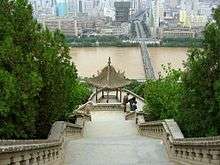
The city is located in a narrow and curved river valley with surrounding mountains causing it to be hemmed in blocking a free flow of air. According to the National Environmental Analysis released by Tsinghua University and The Asian Development Bank in January 2013, Lanzhou was among one of ten most air polluted cities in the world.[18] Air quality reportedly was so poor that at times one could not see Lanshan, the mountain rising up along the south side of the city.[19] Lanzhou is also the home of many factories, including some involved in petroleum processing, and suffers from large dust storms kicked up from the Gobi Desert, especially in the winter and spring. In 2011, using Chinese statistics, the World Health Organization reported that Lanzhou had the worst air quality among eleven western Chinese cities. Its annual mean PM10 µg/m³ of 150 is 7 times the safe level established by the World Health Organization. It was worse than Beijing with its reading of 121.[20]
Since then, authorities have taken measures to improve air quality, which have largely been successful. "Thirteen polluting enterprises with excessive capacity have been closed, more than 200 highly polluting enterprises were suspended in winter, and 78 industrial enterprises have moved to an industrial park outside the city."[19] In 2015 it was awarded China's climate progress title. As a city once unable to be spotted from satellites, Lanzhou has taken various measures to combat air pollution in recent years, having reduced its Air Pollution Index at the fastest speed across China.[21] According to the 2018 WHO database,[22] of 2700 towns listed, Lanzhou has the 158th highest level of PM 2.5 pollution, with an average of 54 micrograms per cubic meter (twice that of Milan). The large particle PM10 remains high, at 132 micrograms per cubic meter, in part as a result of sand storms.
The reach of the Yellow River at Lanzhou carries a high load of silt, giving the river its characteristic muddy appearance; however water quality in this reach is better than the "fetid outflow that barely passes for water two hours downstream" (2008).[23] In recent years, several specimens of the endangered Chinese giant salamander have been found in and near the Yellow River in Lanzhou.[24][25][26][27]
On April 11, 2014 Lanzhou officials advised residents not to drink tap water, because benzene levels were 20 times the national limit of 10 micrograms per liter.[28] The city water supply suspected industrial chemical production to be the culprit, similar to what happened in the 2005 Jilin chemical plant explosions.[29]
Earthquakes
Lanzhou experiences earthquakes regularly, although usually at low intensities. In 1920 a large earthquake was experienced killing more than 100,000 people in Ningxia and Eastern Gansu province, although only 42 were killed in Lanzhou itself, the low number being attributed to the strong yet flexible nature of the wooden buildings in the city.[30]
Sport
The 14,000-capacity Northwest Minzu University Stadium[31] is one of the main sports venues in the city. It is mostly used for football games. A new sports center complex, including a stadium with a capacity of 60,000 spectators and a swimming hall, is under development.[32]
Lanzhou previously had a professional soccer team named Gansu Tianma F.C. from 1999 to 2003.[33] The team played in Chinese Football Association Yi League from 1999 to 2001 and bought a position in the Jia League from Tianjin Lifei. The team relocated to Ningbo, Zhejiang and changed their name to Ningbo Yaoma (宁波耀马) in 2003.[34] The team later relegated to the Yi League in 2004 and sold to Dongguan Dongcheng, who moved the club to the Hong Kong First Division League.
Former England international Paul Gascoigne played four games in both a playing and coaching role for Gansu in 2003,[35][36] scoring two goals,[37][38] before returning to England after falling out with the club,[39][40] as his mental state meant that he had to return to America for treatment against drink and depression.[41]
Administrative divisions
| Map | ||||||
|---|---|---|---|---|---|---|
| Name | Simplified Chinese | Hanyu Pinyin | Population (2010 census) |
Area (km²) | Density (/km²) | |
| City proper | ||||||
| Chengguan District | 城关区 | Chéngguān Qū | 1,278,745 | 220 | 5,812.47 | |
| Qilihe District | 七里河区 | Qīlǐhé Qū | 561,020 | 397 | 1,413.14 | |
| Xigu District | 西固区 | Xīgù Qū | 364,050 | 385 | 945.58 | |
| Anning District | 安宁区 | Ānníng Qū | 288,510 | 86 | 3,354.76 | |
| Suburban | ||||||
| Honggu District | 红古区 | Hónggǔ Qū | 136,101 | 575 | 236.69 | |
| Rural | ||||||
| Yongdeng County | 永登县 | Yǒngdēng Xiàn | 418,789 | 6,090 | 68.76 | |
| Gaolan County | 皋兰县 | Gāolán Xiàn | 131,785 | 2,556 | 51.55 | |
| Yuzhong County | 榆中县 | Yúzhōng Xiàn | 437,163 | 3,362 | 130.03 | |
Lanzhou New Area
On August 20, 2012, Lanzhou New Area was approved by the State Council of China's Central Government as the fifth state-level new special economic development zone (followed by Pudong of Shanghai, Binhai of Tianjin, Liangjiang of Chongqing, Zhoushan of Zhejiang), which is also the first state-level new area in the northwest of China.[42] The area has been described as a ghost town, as it has failed to attract anywhere close to the anticipated number of inhabitants.[43]
Tourism
- The Five Spring Mountain Park (五泉山公园) was built at the northern side of Gaolan Mountain, is famous for its five springs and several Buddhist temples.
- The Zhongshan Bridge (中山桥) was the first permanent bridge over the Yellow River.
- Baita Mountain Park (白塔山公园) was built close to the mountains at an elevation of 1,700 metres (5,600 ft) and opened in 1958 across Zhongshan Bridge.
- The Lanzhou Botanical Garden (兰州植物园), located in the Anning District, has a large variety of trees, flowers and other plants.
- Xiguan Mosque (西关清真寺), is one of the larger mosques in China.
- On Wuquan Mountain (五泉山), many ancient architectural sites are located.
- Xinglong Mountain (兴隆山), is covered with thick pine forests and scattered with colorful temples.[44]
- Lutusi ancient government (鲁土司衙门旧址), a large complex of ancient governmental buildings.[45]
Museums
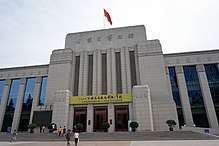
- Gansu Provincial Museum (甘肃省博物馆), displays archaeological and fossil finds from Gansu and exhibitions on Gansu's history.
- Lanzhou Museum (兰州市博物馆), is an important cultural unit on the Silk Road. As of October 2017, the collection contains more than 13,000 pieces of collections, including pottery, porcelain, bronze, calligraphy, coins, jade, stoneware, etc. There are 52 national first-class cultural relics, 78 national second-level cultural relics and 682 national third-level cultural relics.[46]
- Gansu Art Museum (甘肃艺术馆), Providing a broad display and external communication platform for artists.[47]
- Lanzhou City Planning Exhibition Hall (兰州市规划展览馆), showing the profound Yellow River culture of Lanzhou and integrating indoor exhibition, architectural concept and urban characteristics.[48]
- Lanzhou Painted Pottery Museum (兰州彩陶博物馆), The total number of collections is 250, including 50 precious cultural relics, it displays the painted pottery civilization represented by the cultural pottery of Majiayao.[49]
- Gansu Science and Technology Museum (甘肃科技博物馆) sound, light, electricity and other high-tech means will be fully adopted, and the way of teaching and learning will enable visitors to embrace modern science in a pleasant atmosphere.[50][51]
Economy

Productivity
Since 1949 Lanzhou has been transformed from the capital of a poverty-stricken province into the center of a major industrial area.
The GDP per capita of Lanzhou was 25,566 (RMB) (US$3,681) in 2008, ranking it at number 134 among 659 Chinese cities. In 2015, the GDP per capita had grown to 57,191 RMB (US$9182.28)[52] and the city ranked at place 100 for total GDP of Chinese cities.[2]
Institutions
The International Solar Energy Center (UNIDO-ISEC) is located in Lanzhou's Chengguan district.[53]

Natural resources
There is a thermal generating plant supplied with coal from fields in Qinghai. In addition, there is a hydroelectric station at Zhulama Gorge in Gansu, and a large multipurpose dam has been built in the Liujia Gorge on the Yellow River above Lanzhou.[54]
Industry
Main industries include textile mills, rubber processing and fertilizer plants, an oil refinery, petrochemicals, machinery, and metallurgical industry.
Gansu has one of the largest oil refineries in the country and Lanzhou itself is the center of the province's petrochemical industry.[55] The refinery is linked to the fields at Yumen by pipeline. It also manufactures equipment for the oil industry.
Lanzhou has a large textile industry, particularly noted for the production of woolen and leather goods. In addition, Lanzhou produces locomotives and rolling stock for the northwestern railways, as well as machine tools and mining equipment. Aluminum products, industrial chemicals, and fertilizers are produced on a large scale, and there is a large rubber industry. Copper is mined in nearby Gaolan.
Lanzhou has been one of the centers of China's national nuclear power industry since the 1960s.
Transportation
Airlines
Lanzhou Zhongchuan Airport is the main airport serving Lanzhou, it is located 70 km (43 mi) north of Lanzhou. It opened for public service in 1970.[56]
The airport offers direct connections to over 70 international and domestic destinations.
Railway

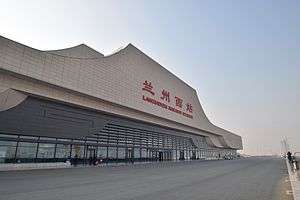
Subway
Lanzhou was the second city in northwest China to announce the construction of a subway line, in August 2012.[57] The urban railway network, Lanzhou Metro, is planned to consist of six subway lines running 207 km (129 mi). The first line, which is completely underground, opened in June 2019.[58]
Regional
Lanzhou Railway Station is a major railway hub of western China. Every day over 100 passenger trains originate or pass via this station. It is a vital focal point connecting the western provinces with the east. Lanzhou Railway Station is located on Huochezhan Dong Lu, in Chengguan district. Lanzhou West Railway Station is the city's second major railway station, offering connection to high-speed rail services.
Lanzhou Railway Station has the following railway connections:
- Longhai Railway to the east (Xi'an, Zhengzhou, Lianyungang), with connection to the main railway of eastern China supporting direct trains to Beijing, Shanghai, etc. Finished in 1953, it was the first railway to reach Lanzhou.[59]
- Lanxin Railway to the west and northwest (with direct trains to western Gansu and Ürümqi, and further connections to other points in Xinjiang and to Kazakhstan)
- Lanqing Railway to the west and southwest, with direct service to Xining and Lhasa
- Chongqing–Lanzhou railway to southeast, with direct service to Chongqing and Guangyuan
- A line to the north and northeast, with direct service to Yinchuan and Baotou
- Lanzhou–Zhongchuan Airport Intercity Railway between Lanzhou Railway Station and Lanzhou Zhongchuan International Airport.[60]
- Lanhe Railway (under construction) to Linxia and Hezuo.
High speed rail
New high-speed passenger-only railways are completed both toward the east (the Xuzhou–Lanzhou high-speed railway) and the west (the Lanzhou–Xinjiang high-speed railway). These services only stop at Lanzhou West Railway Station. The Zhongwei–Lanzhou high-speed railway and Chengdu–Lanzhou high-speed railway are under construction.
Freight rail
Lanzhou forms an important link in one of the routes of the Eurasian Land Bridge and also provides rail access to Qinghai, Xinjiang and Tibet further to the west.[61] A large rail freight terminal has recently been constructed to accommodate increasing volumes of rail freight and Lanzhou is home to China's fourth largest marshalling yard.[62][63]
Regular freight services connect Lanzhou to destinations including Chongqing, Hamburg, Almaty and Kathmandu.[64]
Road network
In 2016, Lanzhou was ranked 4th of Chinese cities with the worst rush hour traffic jams.[65] However, by 2017, it dropped to 33rd place.[66]
Highways
Bus services
.jpg)
For long distance buses, there are three major bus stations in the urban area, West Bus Station[67] in Xiaoxihu neighbourhood, East Bus Station[68] near Lanzhou Station and South Bus Station[69] near G75 Lanzhou–Haikou Expressway terminus. Furthermore, there are a total of 132 local city bus lines.[70] These have their main node station at Xiguan.
Lanzhou has a noted bus rapid transit system which opened in 2013 and won the city an honorable mention at the 2014 Sustainable Transport Awards.[71][72]
Bike sharing system
An in 2014 inaugurated bike sharing system covers mostly the Chengguan District with 377 stations. The system had a successful start and the number of stations is being expanded.[73][74] However, vandalism proved to be a problem, with 600 (out of a total of 6,500) bikes a year not being returned to the stations.[75] As bikes are not rented out anymore late at night, people reportedly outed their frustration on the bikes in the case they were too late to rent one.[76]
Media
- Gansu People's Press, in Lanzhou, publishes Duzhe, the most widely circulated magazine in China.
- Lanzhou Radio serves the Lhasa and Lanzhou province regions with news and music.
- Gansu Daily, newspaper for Gansu Province, has its editorial offices in Lanzhou.
Culture
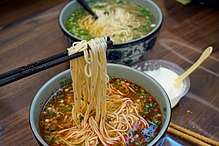
The city is the cultural centre of Gansu. It is home to many different ethnic groups and their respective cultures, but the most prominent three groups are the Han, Hui, and Zang.
- Chinese opera: Qinqiang Opera
- Cuisine: Lanzhou beef lamian noodles, many other types of noodles, the root of the lily, and many different kinds of mutton are important elements of Lanzhou's distinct food culture. Lanzhou Beef noodles are well known throughout China. The city of Lanzhou is home to over 1,000 beef noodle restaurants.[77]
- Islam in China: Xiguan Mosque, the mosque was constructed in the Ming dynasty and rebuilt in 1990. It occupies an area of 467 square metres (5,030 square feet) and is one of the most influential mosques in China. The architecture of the mosque predominantly reflects that of Arab architecture.[78]
Colleges and universities
The city is the seat of Lanzhou University, founded in 1909. The National Minorities Institute at Lanzhou and a branch of the Chinese Academy of Sciences are also located in the city.[79] In particular, Northwest Normal University has been the key university at the provincial level, which has prepared over 100,000 teachers in schools across the province Gansu.
List
Note: Institutions without full-time bachelor's degree programs are not listed.
Other public institutions
- Eastern Gansu University
- Gansu Agricultural University (甘肃农业大学), founded 1958
- Gansu University of Chinese Medicine (甘肃中医药大学), Formerly known as Gansu College of Traditional Chinese Medicine, it has contributed to Gansu's medical and health undertakings and social development.[80]
- College of Politics and Law, Gansu (甘肃政法学院), Based in Gansu, radiating to the northwest, facing the country, actively serving local social development and establishment of the legal system.[81]
- Lanzhou University of Arts and Science (兰州文理学院), Composed by the merger of Gansu Institute of Education and Gansu Union University in 2013.[82]
- College of Technology, Lanzhou (兰州工业学院)[83]
- Lanzhou City College (兰州城市学院), founded 1958[84]
- Lanzhou University of Finance and Economics (兰州财经大学), The only financial and economic university in the three provinces of Gansu, Ningxia and Qinghai.[85]
- Lanzhou Jiaotong University (兰州交通大学), founded 1958
- Lanzhou Medical College (兰州医学院) (Lanzhou Medical Institute) incorporated into Lanzhou University
- Lanzhou Niuroumian (Noodle with beef soup) Cultural Research Institute (兰州牛肉面文化研究所)
- Lanzhou University of Technology, (兰州理工大学), founded 1919 (formerly Gansu University of Technology)
- Northwest University for Nationalities (西北民族大学)
- Northwest Normal University (西北师范大学), founded 1902
Healthcare
- People's Hospital of Gansu
- Second People's Hospital of Gansu (see Borden Memorial Hospital, predecessor)
- Third People's Hospital of Gansu
- First People's Hospital of Lanzhou
- Second People's Hospital of Lanzhou
- Lanzhou University First Hospital
- Lanzhou University Second Hospital
- General Military Hospital
- Lanzhou Military Hospital
- Lanzhou Heavy Ion Cancer Treatment Center, joint venture by Sheng De Group, the city government and Chinese Academy of Sciences' Institution of Modern Physics
- Gansu Tumor Hospital
Sister cities
- Albuquerque,

- Akita,

- Ashkhabad,
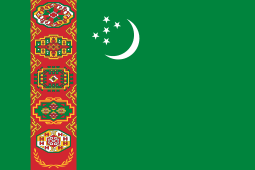
- Chorley,

- Penza,

- Nouakchott,

- Young Shire,
.svg.png)
References
- Cox, W (2018). Demographia World Urban Areas. 14th Annual Edition (PDF). St. Louis: Demographia. p. 22.
- 2015中国城市GDP排名出炉! 第一无悬念. January 21, 2016. Archived from the original on May 21, 2016.
- Jun Jing (1996), The Temple of Memories: History, Power, and Morality in a Chinese Village, Stanford: Stanford University Press, p. 4.
- "Illuminating China's Provinces, Municipalities and Autonomous Regions". PRC Central Government Official Website. Retrieved May 17, 2014.
- 兰州市第六次全国人口普查主要数据公布我市人口年龄结构尚处“红利期” (in Chinese). Lanzhou People's Government. May 25, 2011. Archived from the original on March 4, 2016. Retrieved July 20, 2015.
- Xian, Xiaowei; Zhang, Linyuan; Ai, Nanshan; Wihelm, Wohlke (March 1, 1991). "On the relation between the evolution of natural environment and human factors and the development of urban settlement—Take the Lanzhou Valley Basin as an examples". Chinese Geographical Science. 1 (1): 42–53. doi:10.1007/BF02664455 – via Springer Link.
- "Silk Road, North China". The Megalithic Portal.
- 城内外(116)黄河之都金城兰州 [Yellow River Capital Jincheng Lanzhou].
- 兰州空战:中国空战史上最惨烈的一次消耗战! (in Chinese). Archived from the original on March 23, 2016.
- Stéphane William Darrach Halsey, Bernard Johnston (M.A.) (1989). Collier's encyclopedia: with bibliography and index, Volume 14. Macmillan Educational Co. p. 285. Retrieved June 28, 2010.
- Stéphane William Darrach Halsey, Bernard Johnston (M.A.) (1983). Collier's encyclopedia: with bibliography and index, Volume 14. Macmillan Educational Co. p. 285. Retrieved June 28, 2010.
- Stéphane William Darrach Halsey, Bernard Johnston (M.A.) (1983). Collier's encyclopedia: with bibliography and index, Volume 14. Macmillan Educational Co. p. 285. Retrieved June 28, 2010.
- "Archdiocese of Lanzhou [Lanchow]". Catholic-Hierarchy.org. David M. Cheney. Retrieved January 21, 2015.
- "CATHOLIC ENCYCLOPEDIA: Vicariate Apostolic of Northern Kan-Su". www.newadvent.org. Retrieved August 14, 2017.
- 兰州城市介绍以及气候背景分析. Weather China (in Chinese). 中国气象局公共气象服务中心. Retrieved July 27, 2015.
- 中国气象数据网 - WeatherBk Data (in Chinese). China Meteorological Administration. Retrieved April 15, 2020.
- 中国地面国际交换站气候标准值月值数据集(1971-2000年). China Meteorological Administration. Archived from the original on September 21, 2013. Retrieved May 25, 2010.
- "WEATHER & EXTREME EVENTS 7 of 10 Most Air-Polluted Cities Are in China". JAN 16, 2013. Imaginechina/Corbis. http://news.discovery.com. Retrieved September 1, 2014.
- "Across China: NW China city's air pollution transformation". August 14, 2014.
- WHO report OAP_database_8_2011.xls
- "China's far west poised to overtake Hebei in a "most polluted" list". China Dialogue. June 15, 2016.
- "WHO | WHO Global Ambient Air Quality Database (update 2018)". World Health Oorganization.
- Rob Gifford (January 6, 2008). "Yellow River Pollution Is Price of Economic Growth". NPR.
- 兰州三名男子黄河边捡到娃娃鱼 已交到派出所_网易新闻. news.163.com.
- 皋兰什川农民在小峡电站库区发现罕见“娃娃鱼”_网易新闻. news.163.com.
- "Sina Visitor System". passport.weibo.com.
- http://www.iqiyi.com/w_19rwtoudcd.html
- Li, Xiaorong (李小荣) (April 11, 2014). 兰州自来水苯含量严重超标. Xinhua Gansu (in Chinese). Archived from the original on March 4, 2016. Retrieved July 27, 2015.
- Spegele, Brian (April 11, 2014). "Water Scare Hits Chinese City of Lanzhou". Wall Street Journal. Retrieved April 14, 2014.
- "The Earthquake," E. J. Mann in Links with China and Other Lands, No. 31, April 1921, Lanzhou: China Inland Mission (quarterly) Bound volume in MS 380302, Papers of Ebenezer and Mabel Mann, SOAS, 331.
- "Daum 카페". cafe.daum.net. Retrieved August 14, 2017.
- 兰州新城区崔家大滩:搁置六年的"奥体梦". Archived from the original on June 30, 2016. Retrieved May 25, 2016.
- "Archived copy". Archived from the original on October 5, 2013. Retrieved July 27, 2015.CS1 maint: archived copy as title (link)
- Yi, Cai (September 15, 2003). 甘肃天马改名宁波耀马 武汉队暗喜去宁波. Sina Sports 体育周报 (in Chinese). Retrieved July 27, 2015.
- "Gascoigne nets contract in China". ESPN. January 27, 2003. Retrieved August 7, 2014.
- Johnson, William (January 28, 2003). "Gleeful Gascoigne nets job in China". The Telegraph. Retrieved August 7, 2014.
- "Gazza scores in winning China debut". ESPN. March 29, 2003. Retrieved August 7, 2014.
- "Gazza scores on China debut". BBC. March 29, 2003. Retrieved August 7, 2014.
- Simons, Raoul (August 5, 2003). "Gazza: I'm feeling a lot better these days". London Evening Standard. Retrieved July 27, 2015.
- Scott, Matt (June 26, 2003). "Gascoigne faces the threat of legal action". Guardian News. Retrieved July 27, 2015.
- "Chinese club hand Gazza ultimatum". ESPN. June 21, 2003. Retrieved August 7, 2014.
- "China approves new state-level SEZ in Gansu". The Global Times. Xinhua. Retrieved September 3, 2012.
- "China goes west: a ghost city in the sand comes to life". March 21, 2017 – via The Guardian.
- "Xinglong Mountain, Lanzhou, Gansu". www.travelchinaguide.com.
- 鲁土司衙门旧址. March 12, 2012.
- http://www.lzmuseum.org/info_lianxi.htm
- 我的简介-甘肃艺术馆-文化艺术网. gsysg.orgcc.com.
- http://www.gs.xinhuanet.com/news/2012-1/31/c_114216595.htm%5B%5D
- http://www.gsww.gov.cn/Web_Detail.aspx?id=8915
- sound, light, electricity and other high-tech means will be fully adopted, and the way of teaching and learning will enable visitors to embrace modern science in a pleasant atmosphere.
- "Gansu completes its first science and technology museum construction". China Daily. January 23, 2015.
- 2015甘肃各市gdp排名 2015年甘肃各市GDP和人均GDP排名一览表. May 19, 2016. Archived from the original on May 21, 2016.
- "UNIDO-ISEC". Retrieved July 23, 2015.
- "China China Landscape – Yellow River Tour". www.asia-planet.net. Retrieved August 14, 2017.
- 兰州石化.
- 从“晴通雨阻”到“一日千里”. Gansu Daily (in Chinese). September 28, 2009.
- 兰州城市轨道交通工程开工奠基 刘伟平冯健身赵广发欧阳坚出席奠基仪式. gansudaily.com.cn (in Chinese). Archived from the original on October 15, 2012. Retrieved April 30, 2015.
- 6月23日兰州轨交1号线试运营. 兰州新闻网. June 21, 2019. Retrieved June 26, 2019.
- 西起陇原东到海,回头已是百年身--陇海铁路传略. Xinhua News Gansu. April 29, 2011. Archived from the original on September 24, 2015. Retrieved July 27, 2015.
- 敦煌至格尔木和兰州至中川机场铁路开工建设 [Work started on the Dunhuang-Golmud Railway and on the railway from Lanzhou to Zhongchuan Airport]. houchepiao.com. December 23, 2012. Archived from the original on January 5, 2015. Retrieved July 27, 2015.
- ""Lanzhou" Central Asia International Freight Train Makes its Maiden Trip from Lanzhou New Area". July 5, 2016.
Gansu is the strategic channel connecting to the New Eurasia Land Bridge and the transportation hub connecting Southwest China with Northwest China. It is an important portal for China’s westward opening-up and the strategic base for sub-regional cooperation. At the same time, it is also a place that express trains for Central Asia and Europe must pass through.
- 兰州铁路枢纽北编组站正式开通投入运营. December 22, 2012. Archived from the original on May 17, 2017. Retrieved December 15, 2016.
- 甘肃兰州东川铁路物流中心正式通车运行. December 31, 2012.
- "Regular China-South Asia freight train officially launched". November 1, 2016.
- "Top 10 Chinese cities with the worst jam". November 25, 2016.
- "Traffic jam in Lanzhou greatly alleviated". lanzhou.china.org.cn.
- keyunzhan.com/jieshao-9314/
- https://www.keyunzhan.com/sr-666/
- https://www.keyunzhan.com/jieshao-1925/
- 线路查询|兰州公交集团-官方网站. www.lzbus.com.
- Buenos Aires, Argentina Wins 2014 Sustainable Transport Award, Institute for Transportation and Development Policy
- "Lanzhou BRT". Retrieved August 14, 2017.
- "Lanzhou, China's Bike Share Expands to BRT Corridor". December 8, 2014.
- "Bike Sharing: Lanzhou". Archived from the original on May 28, 2016.
- 兰州公共自行车人为破坏严重一年丢失600多辆. August 14, 2015.
- 兰州公共自行车日骑行人数破6万人次. April 9, 2015. Archived from the original on June 5, 2016.
- "Rolling on a river". November 16, 2012.
- Xiguan Mosque from Muslim2China
- 中国科学院兰州分院. www.lzb.cas.cn (in Chinese). Retrieved August 14, 2017.
- 中医药大学门户首页. Gansu University of Chinese Medicine.
- 甘肃政法大学. College of Politics and Law, Gansu.
- http://www.luas.edu.cn/article/2.html
- 兰州工业学院. www.lzit.edu.cn. 宏点网络网站管理系统. Retrieved August 14, 2017.
- 兰州城市学院. Lanzhou City College.
- 兰州财经大学——Welcome to Lanzhou University of Finance and Economics!. Lanzhou University of Finance and Economics.
- "Albuquerque, New Mexico & Lanzhou, China". Sister Cities International. Archived from the original on May 18, 2015. Retrieved May 25, 2015.
- "Heart crosses over the ocean". Akita City , Akita , Japan. September 22, 2010. Archived from the original on September 23, 2015. Retrieved July 23, 2015.
- 付博. "List of Gansu's sister cities by 2012". gansu.chinadaily.com.cn. Retrieved August 14, 2017.
- "Sister City Relationships between China and the United Kingdom". www.chinese-embassy.org.uk. Retrieved August 14, 2017.
- Council, Hilltops (June 4, 2013). "#didyouknow #youngnsw has a sister city in #China – Lanzhou City, when in Young visit the Chinese Tribute Gardenpic.twitter.com/R81TN99ZcT". Retrieved August 14, 2017.
External links
| Wikimedia Commons has media related to Lanzhou. |
- Lanzhou government website
- Map of Lanzhou

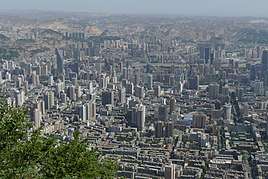


.jpg)
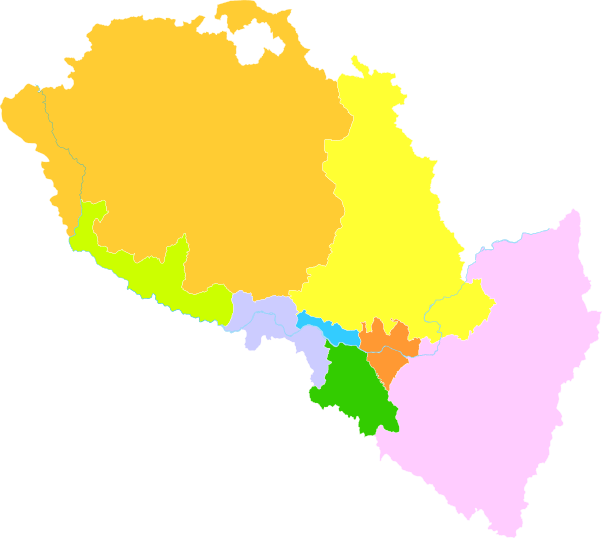
.jpeg)
